Lecture 6: Daily & Annual Motions
Key Ideas:
Daily Motions
- Reflection of the Earth's Daily Rotation
- Circumpolar Stars
Annual Motions
- Reflection of the Earth's Orbital Motion
- Ecliptic: The Path of the Sun
- Zodiacal Constellations
- Solstices & Equinoxes
Daily Motions
Objects in the sky appear to rise in the East and set in the West each
day. This apparent daily motion is a reflection of the Earth's rotation
about its axis.
- Earth rotates once a day (24 hours)
- The sense of rotation is Eastward
- Facing North, rotation is towards the Right.
Apparent Paths
The Apparent Paths of objects are parallel to the Celestial
Equator.
Their orientation depends on your latitude:
- At Equator: perpendicular to the horizon
- At Poles: parallel to the horizon
- Mid-Latitudes: Tilted by (90º–Latitude)
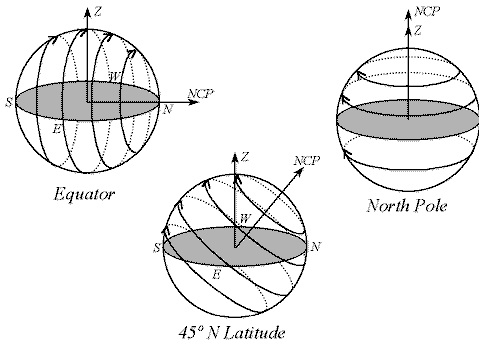
(Click on the image to view it in color at full
resolution [Size: 21Kb])
In Columbus: we are at 40º N, so the paths are tilted by 50 degrees
from the horizon.
Circumpolar Stars
Any star closer than your latitude to your visible celestial pole (north
or south) will always be above your horizon.
These are the Circumpolar Stars
- Ursa Major, Ursa Minor, & Draco are circumpolar
constellations as seen from Columbus
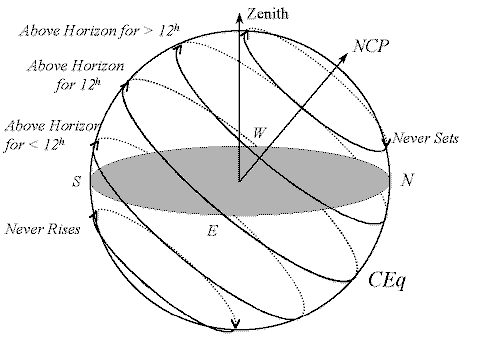
(Click on the image to view it in color at full resolution [Size: 20Kb])
The opposite pole's circumpolar stars never rise above your horizon.
- Ursa Major never rises for latitudes south of about 40° S
Summary of Daily Motions:
Daily Motions of celestial objects reflect the Earth's
daily rotation about its axis:
- Celestial objects to appear to rise in the East and set
in the West.
- Apparent daily paths are parallel to the Celestial
Equator.
- The inclinations of these paths relative to the horizon
depends on the observer's latitude.
- Circumpolar objects are those always above or below the
local horizon.
Annual Motion of the Sun
Over the course of a year, the Sun appears to move a little towards the
East each day as seen with respect to the background stars. This daily
eastward drift is <1° per day (there are 365 days in a year, but
only 360° in a circle).
This apparent motion is a reflection of the Earth's annual orbit
around the Sun.
The Ecliptic
The Ecliptic is the apparent path of the Sun relative to
the stars.
- Great Circle projected onto the Celestial Sphere
- Tilted by approximately 23.5° from the Celestial Equator
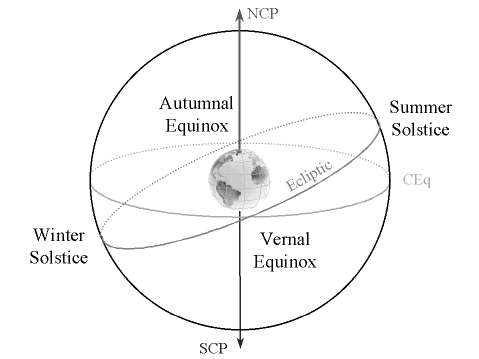
(Click on the image to view it in color at full resolution [Size: 22Kb])
This tilt is called the Obliquity of the Ecliptic
The Obliquity changes slowly over time:
- Now (2005 Jan 10): it is 23° 26' 26.62"
- In 1900 it was 23° 27' 05.97"
The Zodiac
As the Sun moves along the Ecliptic as seen from Earth, it passes
through 12 ancient constellations known as the Zodiac.
- Many date from Babylonian times.
- These are familiar from astrological lore: Aries, Pisces,
Aquarius, Capricorn, Sagittarius, Scorpius, Libra, Virgo,
Leo, Cancer, Gemini, and Taurus.
The Zodical Constellations can be used as a kind of an astronomical
calendar:
- See which Zodiacal constellation is the highest (on your celestial
meridian) at midnight.
- The Sun is in the opposite constellation.
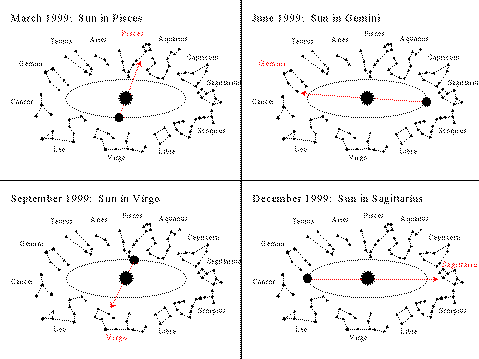
(Click on the image to view it in color at full
resolution [Size: 21Kb], inspired by a drawing by Nick Strobel)
A Note about the Zodiac:
The amount of time the Sun spends in the region of a particular Zodiacal
constellation does not, in fact, correspond to the calendar dates
associated with the twelve "Sun Signs" in the newspaper and
magazine astrology columns. This is no accident. As we will see in Lecture 7, the celestial equator slowly
moves ("precesses") around the sky once every 26,000 years. This means
that the celestial location of the Sun during a given month today has
moved substantially since the common astrological traditions were
codified by Ptolemy during the 2nd century AD. In fact, according to
the constellation boundaries established by the IAU in 1888, at the
present time the Sun actually passes through 13 constellations
over the course of a year! In late November the Sun crosses over the
northern part of Scorpius for about 5 days, after which it passes into
the constellation of Ophiuchus until mid-December. Ophiuchus is, of
course, not one of the traditional 12 constellations of the Zodiac. The
amount of time the Sun spends in a constellation is also quite variable,
and nowhere near the uniform time intervals suggested by traditional
astrology. While both astronomy and astrology share common roots in the
distant past, they bear no relation to each other today. Astrology as
now practiced has strayed far from the reality clearly visible in the
night sky.
Solstices
Solstices occur when the Sun is at its maximum northern and southern
declination. The word Solstice is derived from the Latin words
"sol sistere" = "sun" and
"stand still".
Solstices occur twice a year in June and December:
- Summer Solstice: Maximum northern declination of
the Sun (June).
- Winter Solstice: Maximum southern declination of
the Sun (December).
These names are ambiguous, as while in June it is Summer in the Northern
Hemisphere, it is Winter in the Southern Hemisphere (and similarly
flipped during December). You may occasionally see these called the
"June" and "December" Solstices, respectively, in an attempt to not have
a "Northern" bias, but this alternative is not widely used.
Equinoxes
Equinoxes occur when the Sun crosses the Celestial Equator. Derives
from the latin "equinoctis" = "equal
night".
Equinoxes occurs twice a year, during March and September.
- Vernal Equinox: Sun crosses the Celestial Equator moving
North (occurs in March)
- Autumnal Equinox: Sun crosses the Celestial Equator moving
South (occurs in September)
Like with the Solstices, there is a similar North/South ambiguity in
their related seasons. In this case, however, the use of the latinate
names (Vernal instead of Spring), signifies that we are using a strict
astronomical definition that is agreed upon worldwide.
Length of the Day
The length of the day depends on the location of the Sun along the
Ecliptic.
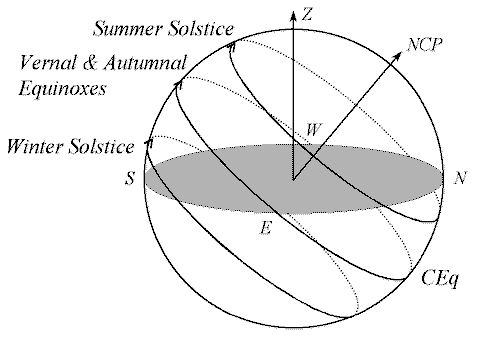
(Click on the image to view it in color at full resolution [Size: 18Kb])
Vernal & Autumnal Equinoxes:
- In 2006 these occur on March 20 and September 22, respectively.
- The Sun rises due East and sets due West.
- Day and Night have equal lengths (12 hours each).
Summer Solstice:
- Occured on June 21 in 2006.
- The Sun rises in the Northeast, and sets in the Northwest
- Day is longer than Night in the Northern Hemisphere
- Day is shorter than Night in the Southern Hemisphere
Winter Solstice:
- Occurs on December 22 in 2006.
- The Sun rises in the Southeast, and sets in the Southwest
- Day is shorter than Night in the Northern Hemisphere
- Day is longer than Night in the Southern Hemisphere
Summary of Annual Motions:
Annual Motions reflect the Earth's orbit around the Sun:
- The Ecliptic: Sun's path relative to the stars.
- The Obliquity of the Ecliptic: 23.5°
- Constellations of the Zodiac along the Ecliptic.
- Equinoxes: Sun crosses the Celestial Equator.
- Solstices: Sun at maximum North & South declination.
- Length of the day depends on the location of the Sun
along the Ecliptic.
Return to [
Unit 2 Index
|
Astronomy 161 Main Page
]
Updated: 2006 September 23
Copyright © Richard W. Pogge, All Rights
Reserved.




